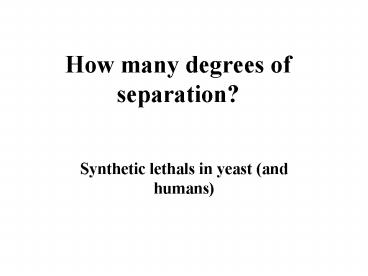How many degrees of separation PowerPoint PPT Presentation
1 / 18
Title: How many degrees of separation
1
How many degrees of separation?
- Synthetic lethals in yeast (and humans)
2
Synthetic phenotypes
Mutant 1 X Mutant 2 Viable
Viable
Mutant 1 Mutant 2 DEAD
WHY?
3
Reasons for synthetic phenotypes(the naïve view)
- The genes encode redundant steps of the same
pathway - The genes are involved in the same pathway but in
different steps - The genes are involved in parallel pathways
- Some interesting but unexplainable biological
connection? (an artifact?)
4
Importance of synthetic phenotypes
- Identify a component of a pathway or process not
identifiable via single mutant genetics - Identify processes or genes that act to buffer
against mutation
5
Ways of finding synthetic mutants
- A mutant may actually be due to two mutations
- Tests of epistasis or enhancement between mutants
with the same phenotype - Enhancer or suppressor screens
- Screen directly-yeast
- Put gene of interest on plasmid with color
selection also on plasmid - Mutagenize and look for mutants where plasmid
cannot be lost
6
Yeast synthetic lethals in the secretory pathway
116/237 same step 68/237 different step 53/237
not in secretion
7
Synthetic lethals-how common?
- Screens with 5 genes, between 3 and 8 interacting
genes were found - Yeast Proteome Database usually less than 10 per
gene, 26 was the max - This is an underestimate, has not been
systematically done
Hartman, Garvik and Hartwell, 2001
8
Cassette for gene deletions
Kan R
ATG
TAA
UPTAG
DNTAG
X
X
YFG
ATG
TAA
9
Generation of haploid double mutants
Del 1-selection 1 Mat a
Del 2-selection 2 Mat a
X
a/a diploid sporulation
Selection 1, selection 2, select for haploids
Mutant 1 mutant 2
10
Screened 132 genes X 4700 deletion strains
- 132 strains either deletions or ts strains
- Each cross repeated three times
- (620,400 x 3!)
- All genes (36 million x 3)
- Multiple interactions checked by tetrad analysis
or random spore analysis
11
How many synthetic lethals would you expect per
gene?
12
How many synthetic lethals would you expect per
gene?
- Average of 34, range from 1-146
- This compares to 8 physical interactions
- Screens with 5 genes, between 3 and 8 interacting
genes were found - Yeast Proteome Database usually less than 10 per
gene, 26 was the max
13
What was interesting in the data?
- Synthetic lethals more abundant when genes had
the same mutant phenotype P10-316 - Synthetic lethals more abundant when genes had
the same subcellular localization P10-70 - Synthetic lethals more abundant when genes were
known to be part of a complex P10-68
14
Network of genetically connected gene functions
15
Networks have predictive value
- CSM3-interaction pattern matched DNA replication
checkpoint genes MRC1 and TOF1 - YMR299c-clustered with dynein/ dynactin-might be
yeast dynein light intermediate gene
16
Do neighbors interact?
SGS1yeast homolog of human Werners syndrome
protein, a DNA helicase
17
Summary
- About 1 of double mutants generated a synthetic
lethal phenotype - Homeostasis/buffering?
- New hypotheses about novel genes
- Implications for variation
18
Relevance to human biology
- Challenge of understanding genetic background
- -7 modifiers of CFTR
- Digenic diseases ROM1 RDS
- Retinal outer segment membrane protein
- Retinal degeneration slow
- Together cause retinitis pigmentosum
- Many complex heterogenous diseases

